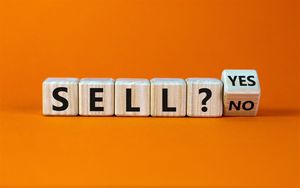
Procter & Gamble (NYSE: PG), the consumer goods behemoth, reported a modest 1% increase in organic sales for the third quarter of fiscal year 2025. This growth, while seemingly positive, tells a story of increasing reliance on higher prices, as organic volume remained stubbornly flat. The Cincinnati-based company's latest earnings underscore a prevalent trend in the consumer packaged goods (CPG) industry: companies are successfully passing on elevated costs to consumers, but at the risk of stagnating purchasing quantities. This delicate balancing act between price and volume presents both a strategic triumph in maintaining profitability and a significant challenge in sustaining long-term growth.
The immediate implications are multifaceted. For P&G, it signals a successful defense of its margins in a persistently inflationary environment, leveraging its portfolio of strong brands. However, the flat volume suggests consumer pushback, with households increasingly scrutinizing their budgets and potentially seeking out cheaper alternatives. For the broader CPG market, P&G's performance is a bellwether, demonstrating that pricing power remains strong for category leaders but also highlighting the growing importance of innovation and value to re-ignite volume expansion.
Higher Prices Propel Sales, Volume Stalls: A Q3 Snapshot
Procter & Gamble's third quarter of fiscal year 2025, spanning January through March, saw net sales decrease by 2% year-over-year to $19.8 billion, a figure that missed analyst forecasts and contributed to a nearly 5% dip in the company's stock price by market close. Despite this, the company achieved a 1% increase in organic sales, a metric closely watched by investors as it strips out the effects of foreign exchange and acquisitions/divestitures. What's particularly striking is that this entire 1% growth was attributed to higher pricing, with organic volume seeing no net change, and mix having a neutral impact.
This reliance on pricing isn't new; P&G has consistently raised prices across its categories, including essential household items like Tide, Pampers, and Gillette, to offset surging input costs for raw materials, labor, and transportation. This strategy has allowed P&G to achieve a 1% increase in diluted and core net earnings per share (EPS) to $1.54 compared to the prior year. However, the flat volume, especially following previous periods where P&G experienced declines in overall volumes despite price increases, suggests that consumers are reaching a saturation point. While brand loyalty for P&G's premium products remains robust in key markets like the U.S., the company has acknowledged some market share loss in regions like Europe, where consumers are more readily trading down to cheaper private labels. The diverging performance across segments—Health Care leading with 4% organic growth, Grooming at 3%, Fabric & Home Care flat, and Baby, Feminine & Family Care seeing a 1% decline—further illustrates varying consumer elasticities and competitive pressures within P&G's diverse portfolio.
Winners and Losers in a Price-Sensitive Market
Procter & Gamble's continued reliance on pricing power has created a dynamic competitive environment, clearly delineating winners and losers within the CPG landscape.
P&G (NYSE: PG) itself largely emerges as a strategic beneficiary in terms of financial performance. By consistently raising prices, the company has successfully boosted revenue and gross margins, leveraging its strong brand equity to maintain profitability. While volume resilience is a concern, P&G's ability to command premium prices for its "superior" products has, for now, insulated it from the worst of inflationary pressures, demonstrating the enduring power of its established brands.
Among its competitors, the impact is mixed. Unilever (NYSE: UL) has also implemented significant price increases, sometimes even exceeding P&G's, and has focused on adaptive pricing and digital transformation to maintain competitiveness. This suggests Unilever is actively trying to mitigate potential "loser" status by finding alternative growth drivers. However, Kimberly-Clark (NYSE: KMB) has at times experienced more significant sales volume declines when implementing price increases compared to P&G, indicating P&G may possess greater pricing power. This could position Kimberly-Clark more as a "loser" in terms of volume resilience, facing a tougher battle to retain market share while raising prices. Ultimately, P&G's aggressive moves force these competitors to re-evaluate their own strategies, either by matching price increases and risking volume loss, or by attempting to differentiate on value or innovation.
The clearest winners in this scenario are private label brands. As national brands like P&G raise prices, the price gap widens, making store-brand alternatives increasingly attractive to budget-conscious consumers. This trend is particularly evident in markets where consumer sensitivity to price is high, leading to a noticeable shift in purchasing habits. Smaller direct-to-consumer (DTC) brands face a more nuanced situation. Some could win by offering compelling value propositions or highly differentiated niche products. However, DTC brands lacking strong brand recognition or distribution advantages could struggle against the pricing power and marketing might of CPG giants, making them potential losers if they can't effectively communicate unique value.
At the receiving end, consumers are arguably the primary losers in the short term. They face higher costs for essential household goods, straining already tight budgets. Many are forced to adjust their purchasing habits, either by buying smaller packages, seeking out promotions, or trading down to less expensive private label brands, potentially sacrificing preferred brands or perceived quality for affordability. This shift reflects growing consumer unease and a widespread search for value.
Industry Impact and Broader Implications: A Shifting CPG Landscape
P&G's strategy of driving organic sales growth primarily through pricing, particularly with flat volumes, sends significant ripples across the entire CPG industry. It underscores a fundamental shift in how consumer goods companies are navigating a persistently inflationary environment and increasingly cautious consumer spending habits.
This approach aligns with a broader CPG trend where companies have leveraged strong brand portfolios to pass on rising costs for commodities, labor, and logistics. P&G's ability to maintain sales growth through pricing, even if volume remains stagnant, indicates that leading CPG players still hold considerable pricing power. However, the flat volume is a crucial indicator of growing consumer price sensitivity. This trend could accelerate the shift towards private-label brands, particularly in categories where product differentiation is perceived as lower. Competitors, while often following P&G's lead in price increases, must now contend with the risk of greater volume erosion, pushing them to find new avenues for value creation beyond simple price hikes. This could lead to intensified "value wars," where companies must get creative with promotions, product bundles, or targeted offerings to retain market share.
Ripple effects extend to partners as well. Retailers like Walmart (NYSE: WMT), which have already felt the impact of manufacturer price increases, continue to pass these costs onto consumers but are also increasingly pushing back against further price hikes from their suppliers. This dynamic creates tension in supplier-retailer relationships, potentially leading to tougher negotiations and demands for increased promotional support. Furthermore, P&G's emphasis on streamlining its supplier base through "Best Total Value" sourcing could impact smaller suppliers or those unable to meet strict efficiency and cost criteria, potentially consolidating power among larger, more established partners.
Regulatory and policy implications are also at play. P&G, along with other major CPG companies, has faced scrutiny from bodies like the Federal Trade Commission (FTC) regarding potential price gouging practices, particularly during periods of economic strain. Such oversight can lead to increased regulatory pressure and potential consumer backlash, impacting brand trust. Furthermore, macroeconomic factors like tariffs directly affect P&G's costs, with the company anticipating an estimated $1 billion in higher costs for fiscal 2026 due to tariffs alone. These costs are often passed onto consumers, contributing to the overall Consumer Price Index and potentially influencing purchasing decisions. Historically, CPG companies have raised prices during inflationary periods, but the current extent of price-driven growth with flat volume is noteworthy, suggesting a critical juncture where innovation and value will be paramount to prevent significant market share erosion.
What Comes Next: Innovation, Productivity, and a Balanced Horizon
Looking ahead, Procter & Gamble is poised for a strategic evolution, signaling a move beyond sole reliance on price increases towards a more balanced approach centered on innovation, accelerated productivity, and targeted market strategies. The company's Q3 2025 performance, while demonstrating pricing power, has underscored the necessity of re-igniting volume growth for sustainable long-term success.
P&G's future strategy hinges on what it terms "irresistible superiority," meaning continuous innovation across products, packaging, brand communication, retail execution, and overall consumer value. The company plans to "close-couple" price increases with innovation, ensuring that higher prices are justified by enhanced product performance and new offerings. For example, recent innovations for 2025 in home care, such as Tide Power PODS® with Downy and Swiffer PowerMop, are designed to offer advanced technology and solutions, thereby supporting premium pricing without alienating consumers. P&G aims for a future where organic sales growth is more evenly split, anticipating a 2-3% increase from volume growth alongside a similar 2-3% from pricing, leading to a normalized revenue growth rate of 4-6%. This indicates a strategic shift towards a deceleration in price growth and a renewed focus on achieving positive volume.
Beyond innovation, P&G is launching a significant two-year initiative beginning in fiscal year 2026 to accelerate growth and value creation through changes in its portfolio, supply chain, and organizational design. This includes a "Supply Chain 3.0" restructuring, involving rightsizing and relocating production to boost efficiency and reduce costs, with a goal of up to $1.5 billion in annual gross productivity savings. The organizational design will also see a leaner, more agile structure, leading to the elimination of approximately 7,000 non-manufacturing roles by 2026. This comprehensive overhaul, coupled with the upcoming CEO transition to Shailesh Jejurikar in January 2026, aims to enhance operational excellence and agility.
Market opportunities include further premiumization, particularly in emerging markets like India and Mexico, where brand reach can be expanded. Digital transformation, AI-driven R&D, and leveraging e-commerce also offer avenues for growth and efficiency. However, significant challenges persist, including macroeconomic headwinds, persistent consumer price sensitivity that could drive further trade-downs to private labels, intense competition, and unfavorable currency fluctuations. Retailer pressure for increased promotions also remains a factor. Potential outcomes range from successful balanced growth, where P&G achieves its projected revenue growth with both price and volume contributions, to a risk of continued volume erosion if consumer resistance to higher prices outweighs the perceived value of innovations.
Conclusion: A Delicate Balance for Future Growth
Procter & Gamble's Q3 2025 performance serves as a critical barometer for the consumer packaged goods industry. The key takeaway is clear: while P&G's pricing power successfully insulated its top-line growth and protected margins amidst inflationary pressures, the flat organic volume signals a tipping point where consumers are becoming increasingly discerning and value-conscious. This reliance on price alone is not sustainable in the long run, and P&G's strategic pivot towards balancing innovation with productivity is a testament to this understanding.
Moving forward, the market will be keenly watching P&G's execution of its integrated growth strategy. The success of its "irresistible superiority" framework, which ties innovation directly to pricing, will be crucial in justifying premium costs and enticing consumers to increase their purchasing volumes. Similarly, the ambitious two-year productivity initiative, encompassing supply chain optimization and organizational restructuring, must yield significant cost savings to fund these innovations and maintain profitability.
Investors should closely monitor several factors in the coming months: the trajectory of organic volume growth, particularly in key segments, as an indicator of consumer acceptance of P&G's value proposition; the impact of accelerated productivity initiatives on operating margins; and the company's ability to navigate persistent macroeconomic headwinds and competitive pressures. The leadership transition to Shailesh Jejurikar will also be a focal point, as he guides P&G through this crucial period of strategic adaptation. Ultimately, P&G's ability to achieve a more harmonious blend of price and volume growth will define its lasting impact and market leadership in an evolving CPG landscape.





